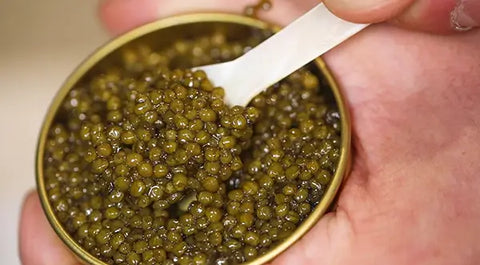Caviar is a world-famous delicacy known for its pearly appearance, rarity, prestige, and of course, its astronomical prices.
While some caviar like the widely recognized Beluga goes for well over $7,500 a kilo, others go for as little as $60 a kilo. That’s 99% less than the premium stuff.
In this guide, we break down the prices of all the different types of caviar and roe and dive into what factors drive prices within the same kinds and between the different types.

Caviar & Roe Prices Summary
If you’re in a rush, here’s a table summarizing prices (USD) of the different types of caviar and fish roe:
| Name | Type | $/oz | $/kg |
|---|---|---|---|
| Almas | Caviar | $990+ | $35,000+ |
| Beluga | Caviar | $200+ | $7,500+ |
| Kaluga | Caviar | $110+ | $3,500+ |
| Ossetra | Caviar | $80+ | $2,400+ |
| Sevruga (Stellate) | Caviar | $80+ | $2,400+ |
| Siberian (Baerii) | Caviar | $60+ | $2,000+ |
| Canadian | Caviar | $60+ | $2,000+ |
| White Sturgeon | Caviar | $60+ | $2,000+ |
| Lake Sturgeon | Caviar | $60+ | $2,000+ |
| Sterlet (Imperial) | Caviar | $50+ | $1,700+ |
| DaVinci | Caviar | $50+ | $1,700+ |
| Shovelnose | Caviar | $40+ | $1,400+ |
| Paddlefish | Caviar | $25+ | $875+ |
| Trout | Roe | $13+ | $460+ |
| Bowfin | Roe | $11+ | $400+ |
| Salmon | Roe | $10+ | $350+ |
| Whitefish | Roe | $10+ | $350+ |
| Bottarga | Roe | $8+ | $275+ |
| Tobiko | Roe | $8+ | $275+ |
| Lumpfish | Roe | $5+ | $175+ |
| Masago (Capelin) | Roe | $2+ | $60+ |
Caviar & Roe Price Factors
As you can see from the table above, the price of different kinds of caviar and fish roe can vary greatly from under $100 per kilo all the way to $35,000.
While the price of certain types of caviar is partially driven by incredibly strong demand and low supply, there are other factors that impact prices:
- Rarity, availability, and quotas
- Time to first spawn (how quickly does the fish mature?)
- Spawning frequency (how often can the fish reproduce?)
- Extraction method (was the fish killed or massaged?)
- Collection process (manual labour, specialized equipment, machinery, etc.)
- Origin (domestic or imported?)
- The aging process (is the caviar aged?)
- Transportation, importing and exporting
To appreciate these factors and how they impact the cost of production, let’s compare masago ($60/kg) and Osetra ($2,400/kg).
Masago is fish roe produced by capelin fish. These fish are small, abundant, found almost everywhere, and begin to spawn as young as two years old. The roe is collected when the fish is killed as the rest of their bodies are used for fishmeal and oils.
Osetra, the fish eggs from the large Russian sturgeon fish, is found in the wild only in the Caspian Sea and begins to spawn as old as 12 years of age.
The eggs are collected while the sturgeon is still alive after a manual ultrasound. The caviar is then manually extracted, filtered, and cleansed before going through a 3-month aging process. A female sturgeon only spawns every 9 to 12 years. Discover where caviar comes from.
As you can see, Osetra sturgeon caviar requires significantly more time, effort, and resources to produce compared to masago roe, which explains why its price is 40 times higher. For more information on this topic, check out our guide on the differences between roe and caviar.
Wild vs. Farmed Caviar Prices
Caviar prices vary greatly even within the same kinds depending on whether they are wild or farmed.
Wild caviar, especially rare and endangered species such as Beluga, will be significantly more expensive for several different reasons such as demand, quotas, and effort required to obtain.
On the other hand, farmed caviar is done in a controlled environment free of many restrictions and cost disadvantages wild caviar is subject to.
Further, wild caviar is typically imported from Europe and Asia, which further drives up costs.

Cruelty-Free Caviar Prices
Fish eggs can be extracted in essentially one of three ways:
- The egg sac can be removed after the fish is slaughtered
- The egg sac can be extracted through a C-section
- The eggs can be massaged out of the fish through induced labour (“The Vivace” or “Milking” method)
No-kill caviar is a relatively new, cruelty-free method of extracting caviar from sturgeons and commands a price premium over the other two extraction methods.
The fish is injected with a compound that induces labour. The caviar then comes out by massaging its belly.
The idea behind its development and use was to preserve and grow the population of this endangered species. However, there is also a financial benefit.
A sturgeon takes at least 7 years to mature and in some cases up to 30. Sturgeons can go on to live up to 100 years old so keeping them alive means more caviar output over the course of its life.
While some argue that the no-kill caviar is not as good, others believe the caviar gets better as the sturgeon matures.
Malossol Caviar Prices
In case you didn’t know, part of the process of making caviar involves a salt cure. This is done both for taste and preservation. Malossol is a Russian word that literally means “a little salt”.
Malossol is caviar that is only lightly cured in salt. It has a shorter shelf life and a higher price tag.
Domestic vs. Imported Caviar Prices
With respect to costs and prices, locally sourced caviar will generally be less expensive, with the exception of rare kinds such as Beluga.
For Americans and Canadians, caviar from domestic sturgeons such as Lake and White will be significantly cheaper than Russian, Siberian, Persian, and European caviar.
Low vs. High-Grade Caviar Prices
Another factor that can impact prices within the same kinds of caviar is their grade.
For those that don’t know, caviar is graded based on size, colour, flavour, and consistency.
- Size: 1mm to 5mm in diameter – larger eggs get higher grades
- Colour: colour grade varies by type of sturgeon
- Flavour: complex nutty, buttery, and moderate fish taste get higher grades
- Consistency: eggs with a nice shape and texture get a premium grading
- Salt content: lightly salt-cured caviar (malossol) highly ranked
As an example, Osetra caviar rated Grade A will be more expensive than one rated Grade B, even if they are from the same source and origin.
Pasteurized vs. Fresh Caviar Prices
Like most whole foods, the degree of freshness has a direct impact on taste, flavour, and of course, price. Pasteurization is the process of heating food at a high temperature in an effort to extend its shelf life.
As such, pasteurized caviar is cheaper than fresh caviar but that comes at the expense of taste. Connoisseurs prefer the taste of fresh caviar and as a result, they are willing to pay a premium for it.
Key Takeaways
- The prices of different types of caviar and fish roe vary greatly
- Caviar prices range from $875/kg to over $7,500/kg
- Fish roe prices range from $60/kg to over $450/kg
- There are several factors that impact the cost and price of caviar and roe
- No-kill caviar is more expensive than C-section caviar
- Wild caviar is far more costly than farmed
- Malossol caviar is more expensive
- Imported caviar is more expensive than domestic
- Caviar is graded and higher-graded caviar is more expensive
Sources:
- CaviarHub.ca Research
- Center for Biological Diversity
- Nechako White Sturgeon – Sturgeon Life Cycle
- WWF – Understanding the Global Caviar Market
- NPR – No-Kill Caviar Aims To Keep The Treat And Save The Sturgeon
- Institute of Food Technologist (IFT) – How Caviar Is Processed
- Food and Agricultural Organization of the United Nations (FAO) – Sturgeons (Acipenseriformes)



